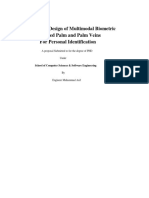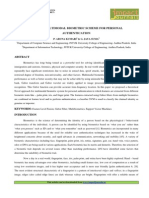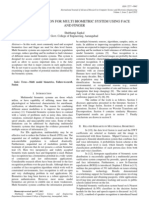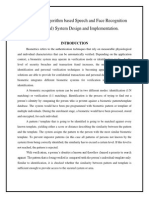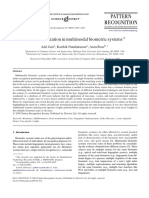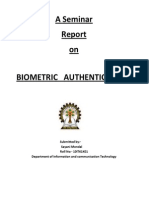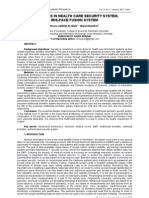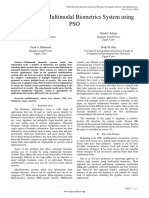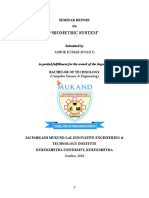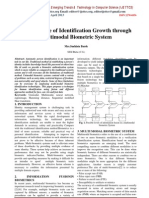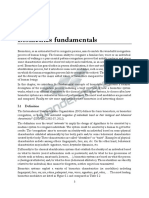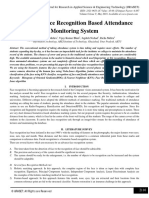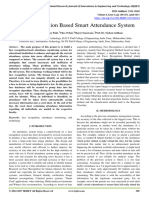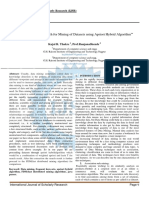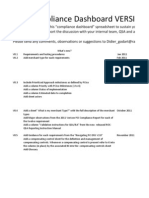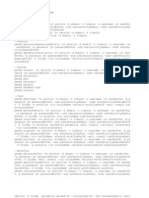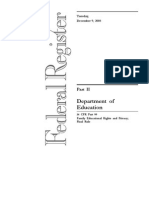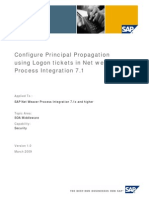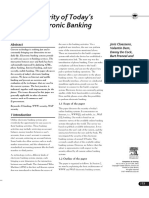Implementation of Unimodal To Multimodal Biometric Feature Level Fusion of Combining Face Iris and Ear in Multi-Modal Biometric System
Implementation of Unimodal To Multimodal Biometric Feature Level Fusion of Combining Face Iris and Ear in Multi-Modal Biometric System
Uploaded by
International Journal of Scholarly ResearchCopyright:
Available Formats
Implementation of Unimodal To Multimodal Biometric Feature Level Fusion of Combining Face Iris and Ear in Multi-Modal Biometric System
Implementation of Unimodal To Multimodal Biometric Feature Level Fusion of Combining Face Iris and Ear in Multi-Modal Biometric System
Uploaded by
International Journal of Scholarly ResearchOriginal Title
Copyright
Available Formats
Share this document
Did you find this document useful?
Is this content inappropriate?
Copyright:
Available Formats
Implementation of Unimodal To Multimodal Biometric Feature Level Fusion of Combining Face Iris and Ear in Multi-Modal Biometric System
Implementation of Unimodal To Multimodal Biometric Feature Level Fusion of Combining Face Iris and Ear in Multi-Modal Biometric System
Uploaded by
International Journal of Scholarly ResearchCopyright:
Available Formats
International Journal of Scholarly Research (IJSR)
Vol-1, Issue-3, 2017
http://www.scholars.org.in
Implementation of Unimodal to Multimodal Biometric Feature Level
Fusion of Combining Face Iris and Ear in Multi-Modal Biometric System"
Gauravweni S. Hedau
Departement of computer science and engg,
G.H.Raisoni Academy of engg. & technology, Nagpur
ghedau1373@gmail.com
Abstract: In this paper is on combining the features face ear cues). A system that consolidates the evidence presented by
and iris to single modal to multimodal combine of the obtain multiple biometric cues is known as a multi-biometric system.
better accuracy improvement as compared to the privies Multi-sensor in which, more than one sensors are used to
system. The paper discusses a new research area to introduce capture information from the presented biometric trait (e.g.,
ear as the feature for multimodal biometric our system is to capacitive and optical sensors for fingerprints). Multi-sample
implement a multimodal an multialgorithmic biometric system when more than one recording of the biometric trait is used
combining Ear iris and Face recognition. We have developed (e.g., multiple face images can be used for creating the
the secure facial features based authentication system Multi template). Multi-algorithmic where the same biometric data
modal biometric system is one of the major areas of study is processed through multiple algorithms (e.g., minutiae and
identified with large applications in recognition system. Single texture based features for fingerprints). Multi-unit or multi-
modal-biometric systems have to challenge with a variety of instance in which, multiple instances of the same biometric
problems such as noisy data, intra-class variations, non trait are used (e.g., information from images of left and right
universality and unacceptable error rates. Some of these irises is combined) Multi-modal when more than one
limitations can be solved with multi modal Biometric systems. biometric traits are used (e.g., a combination of iris and face).
In this paper we are going implement a multi modal biometric The problem of consolidation of information presented by
system combining the feature of face iris and ear modalities to multiple biometric sources or cues from any of the types
obtain better accuracy as compared to the privies based mentioned above is known as information fusion. The
system. information fusion in a biometric system can be carried out at
Keyword: Multi-biometrics, Biometrics, Fusion level, Feature different levels. Sensor Level Information coming from
extraction, PCA, SVM. different sensors is combined. Feature Level The biometric
information extracted in form of features is combined. Score
I. INTRODUCTION Level Match scores of individual biometric comparisons are
Biometric recognition technology can be widely used in the combined. Decision Level The results of individual
field of authentication, security, human computer interaction biometric comparisons are combined.
system, criminal identification and investigation, security. Rank Level When the output of each biometric system is a
Unimodal biometric recognition system variety of problem subset of possible matches (i.e., identities) sorted in decreasing
such as the problem to solved can be overcome by employing order of confidence, the fusion can be done at the rank level.
multimodal biometric system used This is relevant in an identification system where a rank may
be assigned to the top matching identities.
Biometrics: Overall multi-modal biometrics system based on face, iris and
Automated recognition of individuals based on their ear could their connection relationship of physiological and
behavioural and biological characteristics is called biometrics. biological location. It would significantly improve accuracy.
Some examples of biometric characteristics are fingerprint, Multi-modal biometrics based on face and ear is expected to
iris, face (2D and 3D), retina, palm print, hand veins, ear, make a breakthrough in the field of biometrics In this paper we
knuckles, DNA, voice, signature, gait, typing patterns, etc. first the overcome the disadvantage unimodal to multimode
These characteristics are denoted as biometric traits or biometric system. And the combining multimodal biometric
modalities. Since the biometric traits are intrinsically bound to based on face and ear and the discuss new research area
the person, they can be used to establish his identity with high .finally find to better accuracy in this paper.
degree of confidence.
II. RELATED WORK
Multi-biometrics:
An important development in the field of biometrics is to In this section we analysis previously done research work on
combine information from multiple biometric sources (i.e., biometrics system and there different types of biometrics as
International Journal of Scholarly Research Page 16
International Journal of Scholarly Research (IJSR)
Vol-1, Issue-3, 2017
http://www.scholars.org.in
well as previously work done on multi-modal biometric been existing using faces ears and iris modalities for self
systems with different algorithms and design. The produced databases. Multimodal biometrics has resulted
summarizing review of earlier done related work is as follows. enhanced performance in provisions of recognition
Kirti V. Awalkar, Sanjay G. Kanade, Dattatray V. Jadhav, accurateness, FAR and FRR.
Pawan K. Ajmera [1] have build a multi-modal and multi R. Brunelli and D. Falavigna [8] have proposed Multimodal
algorithmic biometric system by combining iris and face. The systems combine the verification presented by different body
iris features are extracted using the Daugmans algorithm character for creating and establishing identity. They has
which results in binary features. For face have used two types proposed a multimodal biometric systems utilized face and
of Features: Gabor filters based and Local Binary Patterns voice features to devlop the identity of an individual. actually
(LBP) based. They have performed broad experiments to uncorrected traits (e.g., ngerprint and iris) are expected to
estimate the system on widely available databases using result in better development in performance than associated
regular well defined protocols. traits (e.g. voice and lip movement).
Lin Zhang, Lida Li, Hongyu Li, and Meng Yang[2] have
proposed a new method for 3D ear identification, that is
LCKSVD_LHST. There donations are mainly from two III. MULTIMODAL BIOMETRIC FOR FEATURE
aspects. They have get used to LC-KSVD, a state-of-the-art LEVEL FUSION FACE IRIS AND EAR TO
model for supervised dictionary learning, to the relevance of COMBINE UNIMODAL
3D ear recognition. Second aspect is for feature extraction, The input images it first given to Viola Jones detection where
they have proposed an approach based on local histograms of the face extraction if face are not found when a new images
STs, which is quite helpful and strong to small placement taken at the input else the face is the process wired created
errors. They have achieved higher recognition rate than the object detection to find out the eyes of the input face. Once the
other competitors evaluated. And apart from all this its eyes are extracted then we will use facial geometry to find out
computational difficulty is extremely low at the test stage, the electronic of eyes, face, fingerprint, etc. Once face, eyes
manufacturing it quite appropriate for large-scale identification and ear are extracted then to find out of feature of the face,
applications. eyes and ear. The find out mainly the structure property of all
Gandhimathi Amirthalingam, Radhamani.[3] have projected the components .For any new images SVM classified apply in
framework of the multimodal biometric system using face and order to get the classification images.
ear. They have also discusses the levels of fusion that are
promising and appreciate the types of difficulties focused by
previous research work in this area.
Javier Galbally, Sbastien Marcel, Julian Fierrez[4] have
present a new software-based fake detection method that can
be used in multiple biometric systems to detect different types
of fraudulent unauthorized access attempts which is made by
third party for wanting the access of some precious system
information or some other important thing. They have set the
objective of proposed system is to improve the security of
biometric recognition architecture, by adding liveness
evaluation in a fast, user friendly, and non-intrusive manner,
through the use of image quality assessment.
Teddy Ko[5] have overviews and discusses the various
scenarios that are possible in multimodal biometric systems
using fingerprint, face and iris recognition, the levels of fusion
that are possible and the integration strategies that can be
adopted to fuse information and improve overall system
accuracy.
A.A. Darwish, R. Abd Elghafar and A. Fawzi Ali [6] have
present study has designed to build up a multimodal biometric
system for personal identification. Investigational results have
shown that integrated face and ear recognition system. He has
implemented this system at different database. At the end he
got result and concludes that combining face and ear is a good Fig: Flow diagram of system modal
method because it offers a high precision and security. In our proposed methodology there are major six step are
Snehlata Barde, A. S. Zadgaonkar, G. R. Sinha[7]have shows, to be followed:
PCA, Hamming Distance based multimodal biometrics has
International Journal of Scholarly Research Page 17
International Journal of Scholarly Research (IJSR)
Vol-1, Issue-3, 2017
http://www.scholars.org.in
1. Created the database: first the created database for of enter of of
the input images saved the database for 100 person in images correct (C)/(B)
enters and more than enteric. database extracted output
2. Pre-processing tested (C)
Pre-processing the second step is the pre-processing (B)
Detected the face path and then apply control point and 5 3 2 2/3*100= 66.66%
encoding the face path. The control point and the 10 10 8 8/10*100=80%
boundary box to used the PCA and histogram 20 20 17 17/20*10=85%
algrothium 30 30 27 27/30*100=90%
40 40 37 37/40*100=92.5%
50 50 47 47/50*100=94%
60 60 57 57/60*100=95%
70 70 66 66/70*100=98.57%
80 80 79 79/80*100=98.75%
90 90 89 89/90*100=98.88%
100 100 99 99/100*100=99%
Table 1: Face, Iris and Ear
3. PCA: PCA is one of the most popular face recognition
algrothium is used the database for the purpose the Number of Number of Number Accuracy
work contain train subject and test subject test enter in images of correct
biometric used face and ear .first the input images to database extracted output (C)/(B)
face presented than pre-pressing detected face path for tested (C)
control point to images to encoding face for histogram (B)
algrothium to detected face using the PCA feature. 10 10 8 8/10*100=80%
20 20 17 17/20*100=85%
30 30 27 27/30*100=90%
40 40 38 38/40*100=95%
50 50 48 48/50*100=96%
60 60 58 58/60*100=96.66%
4. Created GUI: 70 70 69 69/70*100=98%
80 80 79 79/80*100=98.75%
Graphic user interface created and the created database for
matching person identification and evaluation database face Table 2: face and iris
and ear. combine mapping and person name to save to the
database To the feature level combine fusion face ,eyes and
ear. input the 10 images and the testing to find corrected
output.
Face iris and Ear
5 .matching: decision is the matching verification of the person 120
for multimodal biometric system various system to used and
100
various algrothium to use PCA, for feature extraction, viola
Jones face detect SVM classification used. first to the input 80
images than images extracted tested and than corrected output 60
and than to find accuracy to compare the privies system and Face iris and
unimodal to find the accuracy to implementation of the better 40 Ear
accuracy find out of them. 20
0
IV. Experimental and results setup:
5 20 40 60 80 100
Number Number Number Accuracy
Fig 1: face iris and ear
International Journal of Scholarly Research Page 18
International Journal of Scholarly Research (IJSR)
Vol-1, Issue-3, 2017
http://www.scholars.org.in
Recognition, IEEE TRANSACTIONS ON IMAGE
PROCESSING, VOL. 23, NO. 2, FEBRUARY 2014.
Face and Iris [6] Teddy Ko, Multimodal Biometric Identification for
Large User Population Using Fingerprint, Face and
120 Iris Recognition, Proceedings of the 34th Applied
100 Imagery and Pattern Recognition Workshop
(AIPR05) 0-7695-2479-6/05 $20.00 2005 IEEE.
80 [7] A.A. Darwish, R. Abd Elghafar and A. Fawzi Ali,
60 Multimodal Face and Ear Images, Journal of
40 Face and Iris Computer Science 5 (5): 374-379, 2009.
20
[8] Snehlata Barde, A. S. Zadgaonkar, G. R. Sinha,
0 Multimodal Biometrics using Face, Ear and Iris
10 20 30 40 50 60 70 80 Modalities, International Journal of Computer
Applications (0975 8887) Recent Advances in
Information Technology, 2014.
[9] R. Brunelli and D. Falavigna, Person identification
Fig 2: face and iris using multiple cues, IEEE Transactions on Pattern
Analysis and Machine Intelligence,vol. 17, no. 10, pp.
955966, 1995.
V. CONCLUSION [10] Z. Zhang, R. Wang, K. Pan, S. Li, and P. Zhang,
Fusion of near infrared face and iris biometrics, in
Advances in Biometrics, Lecture Notes in Computer
Overall accuracy of Ear -Face facial biometric authentication Science,, 2007, pp. 172180.
system. Will be evaluated and tested under various facial [11] D. Maturana, D. Mery, and A. Soto, Face
images. Developed an various algorithm which combines recognition with local binary patterns, spatial pyramid
features from human Iris, Ear and Face for person verification. histograms and naive bayes nearest neighbour
.We achieved significant improvement in the verification classification, in Proceedings of the 2009
performance. improved recognition accuracy compared to International Conference of the Chilean Computer
unimodal and privies system Science Society, 2009.
[12] A. K. Jain, P. Flynn, and A. Ross, Eds., Handbook of
Biometrics. Springer, 2008.
VI. REFERENCES [13] ISO/IEC CD 2382.37, Information processing
systems Vocabulary Part 37 : Harmonized Biometric
[1] Kirti V. Awalkar, Sanjay G. Kanade, Dattatray V. Vocabulary, 2010.
Jadhav, TSSMs BSCOER, Narhe, Pune, [14] R. Brunelli and D. Falavigna, Person identification
Maharashtra, India. A Multi-modal and Multi- using multiple cues, IEEE Transactions on Pattern
algorithmic Biometric System Combining Iris and Analysis and Machine Intelligence,vol. 17, no. 10, pp.
Face 2015 IEEE International Conference on 955966, 1995.
Information Processing (ICIP) Vishwakarma Institute
of Technology. Dec 16-19, IEEE 2015. [15] B. Son and Y. Lee, Biometric authentication system
[2] Lin Zhang, Lida Li, Hongyu Li, and Meng Yang, 3D using reduced joint feature vector of iris and face, in
Ear Identification Using Block-Wise 6th International Conference on Audio and Video-
[3] Statistics-Based Features and LC-KSVD, IEEE Based Biometric Person Authentication (AVBPA03),
TRANSACTIONS ON MULTIMEDIA, VOL. 18, 2003.
NO. 8, AUGUST 2016.
[16] C. H. Chen and C. T. Chu, Fusion of face and iris
[4] Gandhimathi Amirthalingam, Radhamani. G, A features for multimodal biometrics, in Advances in
Multimodal Approach for Face and Ear Biometric Biometrics, Lecture Notes in Computer Science,,
System, IJCSI International Journal of Computer 2005, pp. 571580.
Science Issues, Vol. 10, Issue 5, No 2, September [17] Y. Wang, T. Tan, and A. K. Jain, Combining face
2013. and iris biometrics for identity verication, in 4th
[5] Javier Galbally, Sbastien Marcel, Julian Fierrez International Conference on Audio and Video-Based
,Image Quality Assessment for Fake Biometric Biometric Person Authentication (AVBPA03), 2003,
Detection: Application to Iris, Fingerprint, and Face pp. 805813
International Journal of Scholarly Research Page 19
International Journal of Scholarly Research (IJSR)
Vol-1, Issue-3, 2017
http://www.scholars.org.in
[18] A. Rattani and M. Tistarelli, Robust multi-modal
and multi-unit feature level fusion of face and iris
biometrics, in Advances in Biometrics, Lecture
Notes in Computer Science, 2009, pp. 960969.
[19] B. Son and Y. Lee, Biometric authentication system
using reduced joint feature vector of iris and face, in
6th International Conference on Audioand Video-
Based Biometric Person Authentication (AVBPA03),
2003.
[20] M. Eskandari and O. Toygar, Fusion of face and iris
biometrics using local and global feature extraction
methods, Signal, Image and Video Processing, vol.
8, no. 6, pp. 9951006, 2014.
[21] A. Jain, K. Nandakumar, and A. Ross, Score
Normalization in Multi- modal Biometric Systems,
Pattern Recognition, vol. 38, pp. 2270 2285, 2005
[22] T. Ahonen, A. Hamind, and M. Pietikainen, Face
description with local binary patterns: application to
face recognition, IEEE Transactions on Pattern
Analysis and Machine Intelligence, vol. 28, no. 12,
pp. 2037 2041, 2006
[23] A. A. Ross, K. Nandakumar, and A. K. Jain,
Handbook of Multibio metrics, ser. International
Series on Biometrics. Springer, 2006.
International Journal of Scholarly Research Page 20
You might also like
- Research ProposalDocument16 pagesResearch ProposalMuhammad AsifNo ratings yet
- Security Scheme by Using Steganography in Multi-ModelBiometric SystemDocument4 pagesSecurity Scheme by Using Steganography in Multi-ModelBiometric SystemInternational Journal of Innovative Science and Research TechnologyNo ratings yet
- Eng-A Novel Multimodal Biometric Scheme-P. Aruna KumariDocument12 pagesEng-A Novel Multimodal Biometric Scheme-P. Aruna KumariImpact JournalsNo ratings yet
- Data Level Fusion For Multi Biometric System Using Face and FingerDocument5 pagesData Level Fusion For Multi Biometric System Using Face and FingerIjarcsee JournalNo ratings yet
- Byahatti 2020 IOP Conf. Ser. Mater. Sci. Eng. 925 012031Document10 pagesByahatti 2020 IOP Conf. Ser. Mater. Sci. Eng. 925 012031Elham SedighiNo ratings yet
- Web of ScopusDocument9 pagesWeb of Scopusp.maheswariopenventioNo ratings yet
- Biometrics in Secure E-TransactionDocument4 pagesBiometrics in Secure E-TransactionREx Ethics100% (1)
- A Multi-Modal Recognition System Using Face and Speech: Samir Akrouf, Yahia Belayadi, Messaoud Mostefai, Youssef ChahirDocument8 pagesA Multi-Modal Recognition System Using Face and Speech: Samir Akrouf, Yahia Belayadi, Messaoud Mostefai, Youssef ChahirNavdeep GoelNo ratings yet
- 16 - 17 March 2012 1331701306P047 Multimodal Biometric System Using Face and Signature A Score Level Fusion ApproachDocument5 pages16 - 17 March 2012 1331701306P047 Multimodal Biometric System Using Face and Signature A Score Level Fusion Approachडॉ.मझहर काझीNo ratings yet
- PHD Synapsis - FormatDocument12 pagesPHD Synapsis - FormatSenthilkumar swaminathanNo ratings yet
- Score Normalization in Multimodal Biometric SystemsDocument16 pagesScore Normalization in Multimodal Biometric Systemsatelie 2No ratings yet
- Dual Integration of Iris and Palmprint For RealizationDocument6 pagesDual Integration of Iris and Palmprint For Realizationeditor_ijarcsseNo ratings yet
- Automated Authentication Using Hybrid Biometric SyDocument32 pagesAutomated Authentication Using Hybrid Biometric SyShubhamNo ratings yet
- Multimodal Biometric Crypto System For Human AutheDocument11 pagesMultimodal Biometric Crypto System For Human Authetech guruNo ratings yet
- A Novel Retina Based Biometric Privacy Using Visual CryptographyDocument5 pagesA Novel Retina Based Biometric Privacy Using Visual CryptographyJothibasu MarappanNo ratings yet
- Automation Attendance Systems Approaches: A Practical ReviewDocument9 pagesAutomation Attendance Systems Approaches: A Practical ReviewBOHR International Journal of Internet of Things ResearchNo ratings yet
- 2012 CVIU IrisReconstruction Galbally PublishedDocument15 pages2012 CVIU IrisReconstruction Galbally Publishedbkvuvce8170No ratings yet
- PDF/JCSSP 2012 431 435Document5 pagesPDF/JCSSP 2012 431 435jit_72No ratings yet
- Multimodal Biometric Cryptosystem For Human Authentication Using Fingerprint and EarDocument15 pagesMultimodal Biometric Cryptosystem For Human Authentication Using Fingerprint and EaraftermathaftermathNo ratings yet
- A Bimodal Biometric Student Attendance SystemDocument8 pagesA Bimodal Biometric Student Attendance SystemJose Hernandez PalancarNo ratings yet
- BiometricDocument25 pagesBiometricRama KrishnaNo ratings yet
- Face Recognition Using Neural NetworkDocument31 pagesFace Recognition Using Neural Networkvishnu vNo ratings yet
- Score Fusion of Finger Vein and Face For Human Recognition Based On Convolutional Neural Network ModelDocument9 pagesScore Fusion of Finger Vein and Face For Human Recognition Based On Convolutional Neural Network ModelFressy NugrohoNo ratings yet
- Biometrics in Health Care Security System, Iris-Face Fusion SystemDocument9 pagesBiometrics in Health Care Security System, Iris-Face Fusion SystemeabrahNo ratings yet
- Review of Multimodal BiometricDocument4 pagesReview of Multimodal BiometricEditor IJRITCCNo ratings yet
- Biometric System SecurityDocument40 pagesBiometric System Securitydelinabeh7169No ratings yet
- Bio Metrics ReportDocument13 pagesBio Metrics ReportShobha SainiNo ratings yet
- Iris Recognition With Fake IdentificationDocument12 pagesIris Recognition With Fake IdentificationiisteNo ratings yet
- 1.1. Background of The StudyDocument34 pages1.1. Background of The StudyManish ReddyNo ratings yet
- A Face Recognition Attendance System With GSM NotificationDocument6 pagesA Face Recognition Attendance System With GSM Notificationmodena tigaNo ratings yet
- Biometric Feature Based Person Unique Identification SystemDocument6 pagesBiometric Feature Based Person Unique Identification SystemsaumyaNo ratings yet
- Multimodal Biometric Identification System Based On Iris & FingerprintDocument8 pagesMultimodal Biometric Identification System Based On Iris & FingerprintInternational Organization of Scientific Research (IOSR)No ratings yet
- Personal Identification Using Iris Recognition System, A ReviewDocument5 pagesPersonal Identification Using Iris Recognition System, A ReviewShakeel RanaNo ratings yet
- Face Recognition Using PCADocument30 pagesFace Recognition Using PCAamit15094775100% (6)
- Mean-Discrete Algorithm For Individuality RepresentationDocument10 pagesMean-Discrete Algorithm For Individuality RepresentationBayan OmarNo ratings yet
- Fast Multimodal Biometric Approach Using Dynamic Fingerprint Authentication and Enhanced Iris FeaturesDocument45 pagesFast Multimodal Biometric Approach Using Dynamic Fingerprint Authentication and Enhanced Iris FeaturesShruti SharmaNo ratings yet
- Highly Secured Online Voting System (OVS) Over NetworkDocument6 pagesHighly Secured Online Voting System (OVS) Over Networkijbui iirNo ratings yet
- Paper 22-An Adaptive Multimodal BiometriDocument8 pagesPaper 22-An Adaptive Multimodal BiometrieshwarirajNo ratings yet
- BiometricDocument11 pagesBiometricManikandan MurugesanNo ratings yet
- Multimodal Biometric For Mobile Attendanceauthentication SystemDocument2 pagesMultimodal Biometric For Mobile Attendanceauthentication Systemtiffany tantriNo ratings yet
- (Biomatrics in Security) : BioinformaticsDocument7 pages(Biomatrics in Security) : BioinformaticsShashank BijweNo ratings yet
- Biometric Authentication Using Human FootprintDocument7 pagesBiometric Authentication Using Human FootprintSaida RasulNo ratings yet
- Improved Security Through Multimodal Biometric Using Fingerprint and IrisDocument4 pagesImproved Security Through Multimodal Biometric Using Fingerprint and IrisAnonymous gF0DJW10yNo ratings yet
- Ageing Adaptation For Multimodal Biometrics Using Adaptive Feature Set Update AlgorithmDocument6 pagesAgeing Adaptation For Multimodal Biometrics Using Adaptive Feature Set Update AlgorithmIkram CheboutNo ratings yet
- "Biometric System": Seminar ReportDocument23 pages"Biometric System": Seminar ReportAshok KumarNo ratings yet
- Face Recognization: A Review: International Journal of Application or Innovation in Engineering & Management (IJAIEM)Document3 pagesFace Recognization: A Review: International Journal of Application or Innovation in Engineering & Management (IJAIEM)International Journal of Application or Innovation in Engineering & ManagementNo ratings yet
- Behavioral Biometrics: MembersDocument4 pagesBehavioral Biometrics: MembersGondala SatvarshNo ratings yet
- Biometrics: Submitted by UmaDocument34 pagesBiometrics: Submitted by UmaVijith P Parambadi100% (1)
- Articles 4Document8 pagesArticles 4Htet Aung LwinNo ratings yet
- 11 CS1AC16 BiometricsDocument10 pages11 CS1AC16 BiometricsAnna AbcxyzNo ratings yet
- V4I206Document8 pagesV4I206surendar147No ratings yet
- A Certificate of Identification Growth Through Multimodal Biometric SystemDocument5 pagesA Certificate of Identification Growth Through Multimodal Biometric SystemInternational Journal of Application or Innovation in Engineering & ManagementNo ratings yet
- Personal Identification Based Final Doc FinishedDocument90 pagesPersonal Identification Based Final Doc Finishedchandra sekharNo ratings yet
- Iris Based Authentication ReportDocument5 pagesIris Based Authentication ReportDragan PetkanovNo ratings yet
- Biometrics Fundamentals: Characteristics" (ISO/IEC2382-37, 2012)Document5 pagesBiometrics Fundamentals: Characteristics" (ISO/IEC2382-37, 2012)Sethu SiyanNo ratings yet
- Real Time Face Recognition Based Attendance Monitoring SystemDocument5 pagesReal Time Face Recognition Based Attendance Monitoring SystemIJRASETPublicationsNo ratings yet
- Facial Recognition Based SmartDocument5 pagesFacial Recognition Based SmartsankannanavargNo ratings yet
- "Implementation On An Efficient Approach For Ranking Based Fraud Detection in AndroidDocument6 pages"Implementation On An Efficient Approach For Ranking Based Fraud Detection in AndroidInternational Journal of Scholarly ResearchNo ratings yet
- Implementation of Ranking Based Fraud Detection SystemDocument6 pagesImplementation of Ranking Based Fraud Detection SystemInternational Journal of Scholarly ResearchNo ratings yet
- "Implementation On An Approach For Mining of Datasets Using APRIORI HybridDocument5 pages"Implementation On An Approach For Mining of Datasets Using APRIORI HybridInternational Journal of Scholarly ResearchNo ratings yet
- Implementation On Health Care Database Mining in Outsourced DatabaseDocument5 pagesImplementation On Health Care Database Mining in Outsourced DatabaseInternational Journal of Scholarly ResearchNo ratings yet
- Implementation On Proxy-Re-Encryption Based Security Mechanism ToDocument5 pagesImplementation On Proxy-Re-Encryption Based Security Mechanism ToInternational Journal of Scholarly ResearchNo ratings yet
- A Brief Review On Different Security Mechanism in Cloud ComputingDocument4 pagesA Brief Review On Different Security Mechanism in Cloud ComputingInternational Journal of Scholarly ResearchNo ratings yet
- Review On Health Care Database Mining in Outsourced DatabaseDocument4 pagesReview On Health Care Database Mining in Outsourced DatabaseInternational Journal of Scholarly ResearchNo ratings yet
- "Implementation On A 3D Image Password": International Journal of Scholarly Research (IJSR) Vol-1, Issue-1, 2017Document7 pages"Implementation On A 3D Image Password": International Journal of Scholarly Research (IJSR) Vol-1, Issue-1, 2017International Journal of Scholarly ResearchNo ratings yet
- 4 SumitkaleDocument5 pages4 SumitkaleInternational Journal of Scholarly ResearchNo ratings yet
- Implementation of Efficient Approach Towards Classification of Semantically Secure Encrypted DataDocument4 pagesImplementation of Efficient Approach Towards Classification of Semantically Secure Encrypted DataInternational Journal of Scholarly ResearchNo ratings yet
- 02 AratiTuleDocument6 pages02 AratiTuleInternational Journal of Scholarly ResearchNo ratings yet
- SakshigabahneDocument3 pagesSakshigabahneInternational Journal of Scholarly ResearchNo ratings yet
- KajalReviewDocument5 pagesKajalReviewInternational Journal of Scholarly ResearchNo ratings yet
- Digital - SignatureDocument28 pagesDigital - SignatureRishabh GuptaNo ratings yet
- ST10092606 - SAND6221 - Assignment (LAPTOP-17OMF238's Conflicted Copy 2022-10-10)Document6 pagesST10092606 - SAND6221 - Assignment (LAPTOP-17OMF238's Conflicted Copy 2022-10-10)tinashe mugadzaNo ratings yet
- Apple SecureCodingGuideDocument123 pagesApple SecureCodingGuidePhilli OneromNo ratings yet
- Sample Application Form (Clix)Document4 pagesSample Application Form (Clix)Digi CreditNo ratings yet
- VMware View Client Protocol Spec 4.5.0 GA PDFDocument38 pagesVMware View Client Protocol Spec 4.5.0 GA PDFpuemer100% (1)
- Glory RZ 100 Currency RecyclerDocument2 pagesGlory RZ 100 Currency RecyclerAgustin Alonso LasenNo ratings yet
- Compliance Dashboard v0.6Document449 pagesCompliance Dashboard v0.6Debanjan DeyNo ratings yet
- University of ZimbabweDocument14 pagesUniversity of ZimbabweZvikomborero Lisah KamupiraNo ratings yet
- Lta 3 5225Document1 pageLta 3 5225prasannaNo ratings yet
- Informatica - Commands - PMCMDDocument2 pagesInformatica - Commands - PMCMDManeet MathurNo ratings yet
- Information Systems For ManagersDocument10 pagesInformation Systems For ManagersSamyak GargNo ratings yet
- CH 10Document49 pagesCH 10qais0883No ratings yet
- TIM - INTERPOL Travel Information Manual 2017 enDocument5 pagesTIM - INTERPOL Travel Information Manual 2017 enLara CruzNo ratings yet
- FERPA December 2008 RegsDocument51 pagesFERPA December 2008 RegsjreadingNo ratings yet
- Security of Mobile BankingDocument13 pagesSecurity of Mobile BankingJehanzeb RaufNo ratings yet
- Mutation and Title Deed Cum Pattadar PassBook - Application FormDocument3 pagesMutation and Title Deed Cum Pattadar PassBook - Application FormSEELAM NARAYANA REDDY100% (1)
- CMRL Asst Manager, Manager 17 Posts Notification 2024 Apply OnlineDocument5 pagesCMRL Asst Manager, Manager 17 Posts Notification 2024 Apply Onlinemogaj51683No ratings yet
- Biometric ATMDocument21 pagesBiometric ATMLokesh KumarNo ratings yet
- Cyber Law and Cyber CrimeDocument37 pagesCyber Law and Cyber CrimeADVOCATE SANJEEV KUMARNo ratings yet
- Create Windows CA Certificate Templates For CUCMDocument32 pagesCreate Windows CA Certificate Templates For CUCMDavid Van HerckNo ratings yet
- Authentication Using Logon TicketsDocument27 pagesAuthentication Using Logon TicketsdyvskNo ratings yet
- Sign Up PublisherDocument5 pagesSign Up PublisherL.C.No ratings yet
- Birlamedisoft: ELV Extremely Low Voltage SystemsDocument56 pagesBirlamedisoft: ELV Extremely Low Voltage SystemsLinweiXiaNo ratings yet
- L1 Security PrinciplesDocument18 pagesL1 Security PrinciplesJayz JoeNo ratings yet
- Internasional JurnalDocument13 pagesInternasional JurnalRestu PratamaNo ratings yet
- Project Report SpsDocument48 pagesProject Report SpsHarDeep Singh75% (4)
- TX AXBP5 U 5 D Wan 236Document2 pagesTX AXBP5 U 5 D Wan 236kyakareyarNo ratings yet
- Voucher Adibanet Voc 7jam 2000 Up 338 08.08.23Document11 pagesVoucher Adibanet Voc 7jam 2000 Up 338 08.08.23Gratisan SkinNo ratings yet
- Initial Server Setup With Ubuntu 16.04Document5 pagesInitial Server Setup With Ubuntu 16.04ArunManojNo ratings yet
- Authority Letter: Particulars of The OwnerDocument1 pageAuthority Letter: Particulars of The Ownersurinder singhNo ratings yet
